Avalanche survivors in Nepal tell of predawn confusion
Loading...
| Katmandu, Nepal
Mountaineers who survived a predawn avalanche high on the world's eighth-tallest peak say they waited an hour for the sun to rise and then saw pieces of tents and bodies of victims strewn around them on the snow.
Italian climber Silvio Mondinelli said he and a fellow mountaineer were asleep when they heard a violent sound and felt their tent start to slide.
"It was only a few seconds and we did not know what happened, but we had slid more than 650 feet," Mondinelli told The Associated Press on Monday. "All we wanted was for it to stop."
The avalanche hit at about 4 a.m. Sunday while more than two dozen climbers were sleeping in tents at Camp 3 on Mount Manaslu in northern Nepal.
At least nine climbers were killed and six are believed still missing. Many of the 10 survivors were injured and were flown to hospitals by rescue helicopters.
Helicopters flew over the slopes on Monday to search for the missing mountaineers as climbers and guides searched on foot. Rescuers brought down eight bodies — four French, one each from Germany, Italy and Spain and a Nepali guide — and were trying to retrieve the ninth from the 22,960-foot area where the avalanche struck, police Chief Basanta Bahadur Kuwar said.
Three French climbers and two Germans were transported to hospitals in Katmandu on Sunday. Two Italians were flown there on Monday — Mondinelli, who has climbed the world's 14 highest peaks, and fellow mountaineer Christian Gobbi.
Mondinelli said a third Italian climber and their Sherpa guide were sleeping in another tent and both were buried by the avalanche and died.
Gobbi said they could not see at first when they looked out of their torn tent because it was pitch dark and they had no light.
"We found someone's boots and put them on," he said.
When the sun rose an hour later, they saw parts of tents scattered across the snow, along with people who had been killed or injured.
They said they were able to assist the injured with the help of Sherpa guides who came up from lower mountain camps. Those who could walk made their way down to the base camp while those who were injured were picked up by helicopters.
At least three of the victims were from the French Alps town of Chamonix, a hub for climbers on Mont Blanc and nearby peaks. An avalanche on a route to the summit of Mont Blanc in July killed nine experienced climbers.
Two French climbers were still unaccounted for as of Monday afternoon, the French Foreign Ministry said. The rescue effort was called off "at least for today, probably definitively," Christian Trommsdorff, president of the French Mountain Guides Syndicate, said on BFM television.
A total of 231 climbers and guides were on the mountain, but not all were at the higher camps hit by the avalanche.
Nepal Mountaineering Department chief Balkrishan Ghimire identified the eight recovered bodies as Fabrice Priez, Philippe Lucien Bos, Catherine Marie Andree Richard and Ludovic Paul Nicolas Challeat of France; German Christian Mittermeyer; Italian Alberto Magliano; Spaniard Marti Roirg Gasull; and Nepali Dawa Dorji.
Sunday's avalanche came at the start of Nepal's autumn climbing season, when the end of the monsoon rains makes weather in the high Himalayas unpredictable. Spring is a more popular mountaineering season, when hundreds of climbers crowd the peaks.
Mount Manaslu, which is 8,156 meters (26,760 feet) high, has attracted more climbers recently because it is considered one of the easier peaks to climb among the world's tallest mountains.
Nepal has eight of the 14 highest peaks in the world. Climbers have said in recent years that conditions on the mountains have deteriorated and risks of accidents have increased, with some blaming global warming.
Avalanches are not very frequent on Mount Manaslu, but in 1972 one struck a team of climbers and killed six Koreans and 10 Nepalese guides.
Ang Tshering of the Asian Trekking agency in Katmandu, who has equipped hundreds of expeditions, said low snow levels and the increased number of climbers on Manaslu have made climbing conditions difficult.
"It used to be a low-risk mountain in the past but now that has all changed," Tshering said, adding that conditions have become more unpredictable.
Associated Press writer Angela Charlton in Paris contributed to this report.







